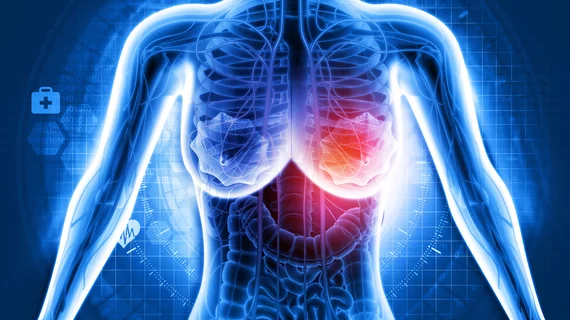Researcher considers greater role of AB-MRI for patients with personal history of breast cancer
Patients with a personal history of breast cancer have typically been recommended for yearly mammography. But in a new editorial published in Academic Radiology, author Lauren Green, MD, of the University of Illinois College of Medicine, makes the case for re-examining options for detecting abnormalities in women that have already had breast cancer and have been treated for it.
Specifically, Green highlights the benefits and drawbacks of available detection techniques, landing on abbreviated breast MRI (AB-MRI) as a desirable option for people with a personal history of breast cancer—and, eventually, perhaps for a wider population as well. Below is a summary of her review.
Mammography
While historically popular, mammography for previous breast cancer patients has demonstrated lower sensitivity and higher rates of interval cancer compared with people who have no personal history of breast cancer, Green wrote, citing Houssami et al.[1]
“This may relate to the presence of post-treatment change masking subtle early findings of malignancy,” she writes.
Mammography’s major limitations center on occasional difficulties revealing breast cancers surrounded by dense fibro glandular tissue.
Digital Breast Tomography (DBT)
Approved in 2011, Green notes that digital breast tomography (DBT) is widely used as a screening tool for people at all levels of risk—sometimes replacing traditional mammography and sometimes used in combination with it. By acquiring multiple mammogram “slices” through the breast, it addresses some of the issues that traditional mammography faces in detecting breast cancers obscured by dense tissue.
But while DBT has shown greater sensitivity for cancer detection in the average-risk population than mammography, Green cites Chikarmane et al. in noting that DBT has similar cancer detection rates as digital mammography for people with a personal history of breast cancer.[2]
Breast MRI
Across different levels of risk, Green notes that Breast MRI “reigns supreme” when it comes to detection, also demonstrating high sensitivity to high-grade disease. Since 2018, the American College of Radiology (ACR) has recommended annual breast MRIs for patients who have a personal history of breast cancer and who either have dense breasts or were diagnosed with breast cancer before age 50.
Breast MRI was once criticized for low specificity, but Green cites data showing that its positive predictive value is on par with that of mammography as radiologist experience increases.[3] However, a long exam time, high cost, and use of intravenous contrast (which carries potential risks of allergic reactions) has taken breast MRI out of consideration for many people.
Abbreviated Breast MRI
Since 2014, abbreviated breast MRI (AB-MRI) has made many of the benefits of traditional breast MRI more accessible to a wider population. Its shorter exam times result in decreased motion artifact as well as an increased ability to scan more patients, as well as lower overall costs. In addition, Green notes that AB-MRI outperformed DBT in detecting malignancy in patients with prior history of breast cancer.
“This has important implications for selecting surveillance methods for this patient population,” she writes.
While sometimes included as a subcategory of breast MRI, Green highlights its distinct advantages as an argument for a separate classification.
“Ideally, AB-MRI will be accepted as its own unique examination. With continued study, AB-MRI could conceivably replace full protocol breast MRI examinations for all patients.”
Reference:
1. Houssami N, Abraham LA, Miglioretti DL, et al. Accuracy and Outcomes of Screening Mammography in Women With a Personal History of Early-Stage Breast Cancer. JAMA. 2011;305(8):790–799. doi:10.1001/jama.2011.188
2. Chakarmane S, Cochon LR, Khorasani R, et al. Accuracy and Outcomes of Screening Mammography in Women With a Personal History of Early-Stage Breast Cancer. American Journal of Roentgenology 2021 217:3, 587-594. doi:https://www.doi.org/10.2214/ajr.20.23976
3. Kuhl, CK, Schrading, S, Leutner, CC, et al. Mammography, Breast Ultrasound, and Magnetic resonance Imaging for Surveillance of Women at High Familial Risk for Breast Cancer. Journal of Clinical Oncology, 23(33), 8469-8476.
Related Breast Cancer Content:
DBT not the superior modality for assessing BI-RADS 4 breast lesions
Imaging features predict survival in patients with luminal breast cancer
Most states' breast cancer screening plans do not comply with USPSTF guidelines
